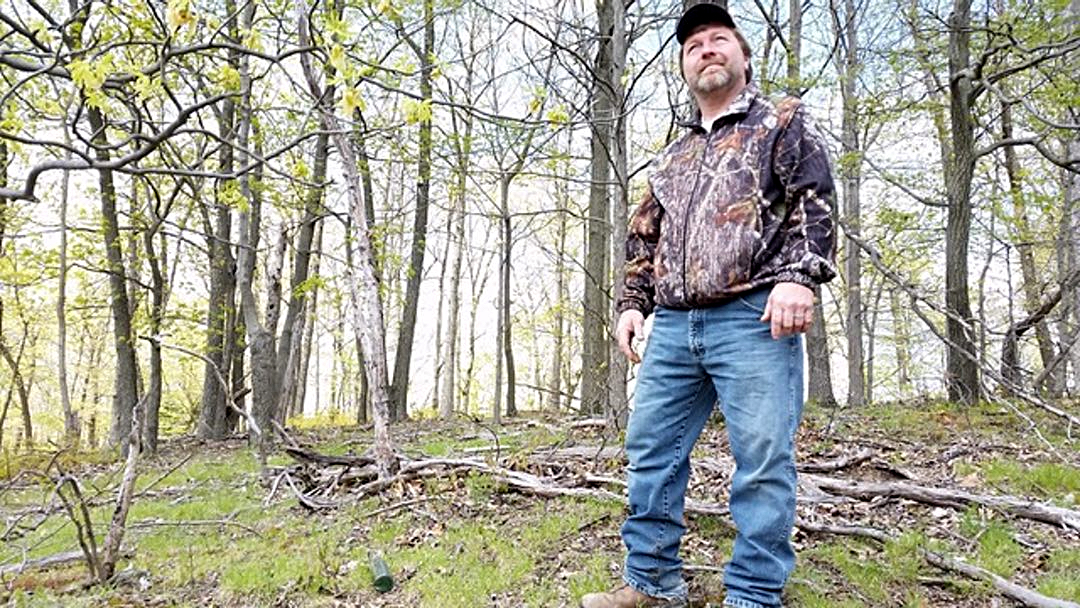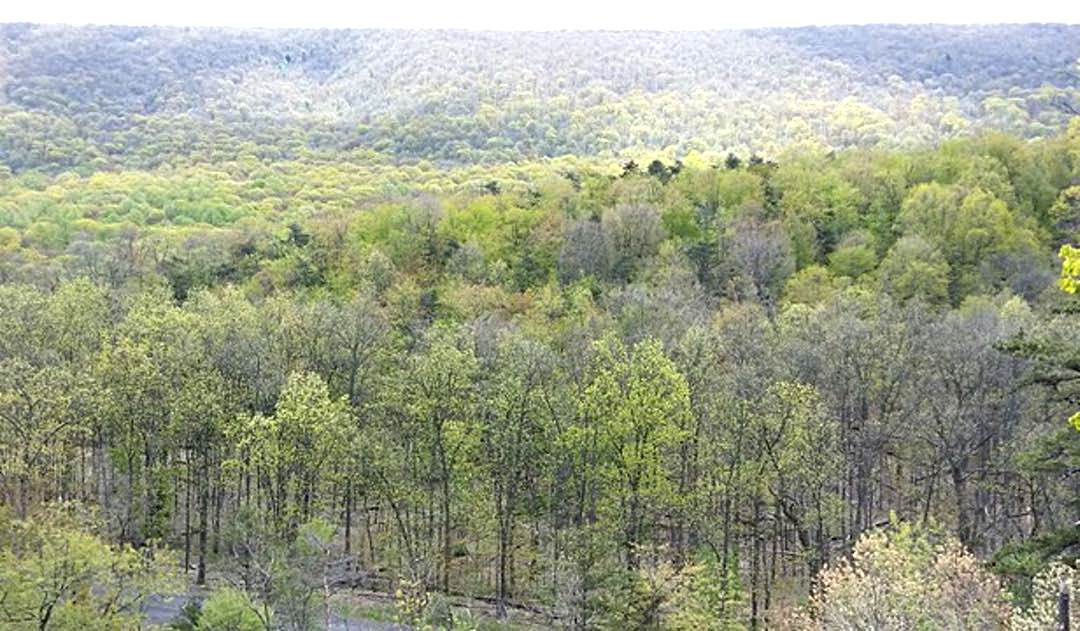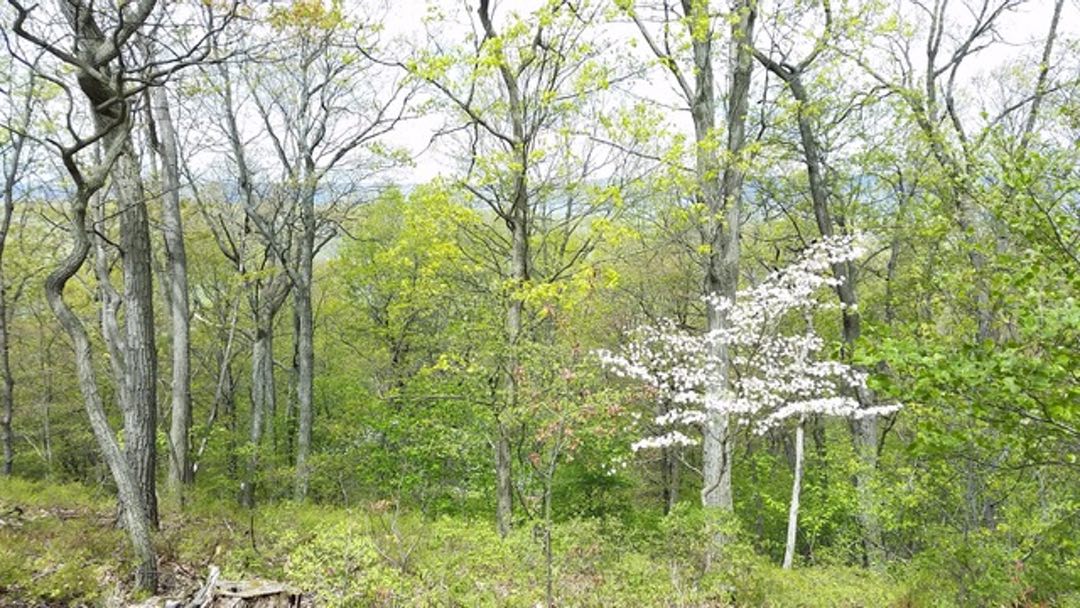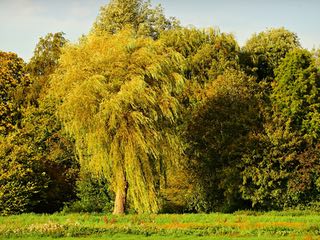
Photo © Gabriel Popkin
How small family forests can help meet the climate challenge
Families own more forest land across America than another other group, even more than the federal government.
By Gabriel Popkin
Sign up for our monthly newsletter!
Tim Leiby had wrapped up a fun but fruitless early-morning turkey hunt and was enjoying an old John Wayne flick when I arrived at Willow Lodge near Blain, Pennsylvania. A few flurries drifted down on this unseasonably cold May morning. After a quick scan of antlers mounted on virtually every wall of the cozy hunting lodge, we headed out for a socially distanced stroll through what Leiby calls “our little piece of heaven.”
This 95-acre woods in south-central Pennsylvania’s ridge-and-valley country is a hunting and hiking refuge co-owned by eight families. As much as he loves it, Leiby knows it could be even better. The forest is still recovering from heavy logging in the 1980s, and it’s full of invasive or unwanted plants — he points out striped maple, princess tree, and barberry — that do little for wildlife and keep desired hardwoods like oak and hickory from regenerating. “Barberry is a terrible invasive around here,” Leiby says. “It’s choking out the ground cover.”
Small family-owned forests like this one make up 38 percent of U.S. forests — together more than 1.5 times the area of Texas, and more than any other ownership type. While most owners want to do right by their land, they rarely have access to the needed expertise or resources. That, however, may be changing. In April, the environmental nonprofits The Nature Conservancy (TNC), American Forest Foundation (AFF), and Vermont Land Trust announced two new programs, powered by a $10-million rocket boost from the tech giant Amazon, to funnel funds from carbon emitters to small landowners like Leiby eager to grow larger, healthier forests.
Program leaders estimate that if scaled up to 4 million acres of family-owned forest (slightly larger than Connecticut), the initiative could offset 18.5 million tons of carbon emissions by 2031. If the projects meet an ultimate goal of signing up 20 percent of U.S. forest landowners, forests could sequester up to 2 billion tons between 2030 and 2100. That’s not going to save the climate — in 2018 alone, the U.S. emitted 5.4 billion metric tons of carbon dioxide — but it could make a dent, roughly like taking 6 million cars off the road for seven decades.
Families “own more forest land across America than another other group, even more than the federal government.”
Climate experts rank sequestration and storage of carbon in trees, which are about half carbon by weight, as among the most affordable and scalable natural climate solutions.
The recent announcement also represents the first hint of how Amazon will spend some of the $100 million that it announced last fall, with lots of fanfare and few details, it would devote to nature-based climate solutions. Experts say it could open the door to get family forest owners off the sidelines and into the fight against global climate change.
“This is the first attempt I’m aware of that is trying to capture a substantially large share of that cohort of forest owners,” says Mike Kilgore, a professor of forestry at the University of Minnesota.

Photo © Gabriel Popkin
Climate experts rank sequestration and storage of carbon in trees, which are about half carbon by weight, as among the most affordable and scalable natural climate solutions. A 2017 study found that such solutions, if implemented globally, could provide more than a third of the near-term climate change mitigation needed to meet the targets spelled out in the 2015 Paris Agreement. U.S. forests are especially potent carbon sinks because almost all of them are recovering from logging. The U.S. Forest Service says that the nation’s forests absorb almost 16 percent of the country’s carbon emissions.
Yet few forests are managed optimally for carbon sequestration. Today, throughout much private forestland, fast logging rotations, “high-grading” that strips out the largest, most valuable trees, and rampant invasive species compromise forests’ ability to pack on carbon and keep it locked away. It’s not that small landowners don’t care about trees or biodiversity — survey after survey finds that they do, passionately. But few have forestry expertise or hire professionals to help with sustainable management, according to Forest Service research.
That’s a problem, because “family forest owners rule,” says Brett Butler, a Forest Service researcher who runs the National Woodland Owner Survey. “They own more forest land across America than another other group, even more than the federal government.”
Environmental groups have sought to direct payments from donors and polluting companies to forest owners in exchange for improved management that boosts carbon storage. To establish credibility, such programs must rigorously measure the sequestered carbon. So far, payments have gone mainly to land trusts, public forest owners, or even to entire tropical states or countries, where large forests can sequester enough carbon to justify monitoring, reporting, and verification expenses.
For family forest owners, carbon markets have offered only tiny payments and required contract terms that were too onerous for most owners, who strongly value privacy and dislike long-term restrictions on their land, according to Marla Markowski-Lindsay and Paul Catanzaro of the Family Forest Research Center in Amherst, Massachusetts. A survey they conducted of Massachusetts forest owners found little participation in existing carbon markets, consistent with surveys conducted elsewhere in the country. “We found interest,” says Markowski-Lindsay, “but there seemed to be some barriers.”
“It’s virtually impossible for small family forest owners to participate” in carbon markets, says Josh Parrish, who directs TNC’s Working Woodlands program, which connects owners of 2,000-acre-plus forests to such markets. “It’s complex and expensive.” To bring family forest owners into the fold, Parrish and his colleagues “quickly realized we had to be much lower cost and more efficient, but still maintain the scientific rigor around forest carbon measurements and forest carbon verification.”
The family forest program is being funded by tech giant Amazon, which has a $100 million partnership with The Nature Conservancy.
If we’re counting on the trees we plant to thrive into the future, and to continue to draw carbon from the atmosphere, getting the seed source as well as the species right is critical.
Last fall, the effort got a big boost. After years of resisting taking action on climate change, the online retailer Amazon abruptly reversed course in September and announced a $100-million partnership with TNC to implement natural climate solutions. What those solutions would be still needed to be figured out. TNC staff told the tech giant they believed they could break the family forest logjam and get thousands of mom-and-pop landowners into the carbon game. The trick was offering to pay landowners for the additional carbon they would store if they adopted one or both of two well-established sustainable forestry practices: growing forests longer before harvesting, and removing invasive plants and small trees that compete with and stunt the growth of larger trees. In April, The Nature Conservancy, the American Forest Foundation, and Amazon announced the opening of the Family Forest Carbon Program to landowners; TNC and Amazon are also supporting a smaller companion program in Vermont.
The program will cover most of the cost of each practice and pay for a consulting forester to help each landowner develop a sustainable management plan designed to enhance not only carbon storage but also wildlife, water quality, and other ecosystem services that forest landowners value. Leiby has signed a contract that will compensate him for forgoing future income-generating harvests and allowing trees to grow to maturity. He hopes the cash and professional advice will also help him manage invasive species and attract more wildlife.
Importantly, say program designers, carbon-enhancing practices are expected to also increase both biodiversity and timber value, making the Family Forest Carbon Program, in theory, a classic example of the kind of win-win that environmentalists seek.
Unlike previous programs requiring up to 99-year contracts, the Family Forest Carbon Program commits landowners for only 10 to 20 years. Program leaders have developed accounting methods that model how carbon stocks will change under the two sustainable forestry practices and verify the gains by comparing measurements of carbon accumulated on a sample of enrolled forests with control plots that do not employ the practices. Those methods should mostly eliminate the need for boots-on-the-ground forest inventories that can cost thousands of dollars per site, cutting monitoring and verification costs by three quarters, according to AFF.
Importantly, say program designers, carbon-enhancing practices are expected to also increase both biodiversity and timber value, making the Family Forest Carbon Program, in theory, a classic example of the kind of win-win that environmentalists seek. “Both of these practices not only store more carbon on the landscape, they also, in the long term at least, generate more timber more sustainably,” says Peter Ellis, a TNC forest carbon scientist. “If you defer your harvest, you can actually get more, higher-quality timber over the next 100 years.”
Still, a typical landowner will not earn a windfall from the program. Someone enrolling 100 acres of forest — a typical small landholding in the U.S. — would stand to earn around $24,500 over 20 years from the program, according to figures provided by AFF. A harvest once trees are mature might add a comparable amount. Most forest owners do harvest trees from their land, though with varying frequency and intensity.
The modest return doesn’t bother Susan Benedict, who along with her brothers is enrolling some of the land they own near State College, Pennsylvania in the program. She and her siblings don’t need their forest to turn a profit; she just doesn’t want to lose money by forgoing a timber harvest to allow trees to grow larger. “My goal is to develop income streams that will for sure take care of the taxes” she pays on the land, she says. “As long as we can pay the taxes, we can keep it.”
Critics of the program argue that carbon markets disincentivize companies from actually reducing their emissions.
Profit is also low on Leiby’s priority list; he has “no idea” how much he might earn from the Family Forest Carbon Program, he says. “The top priority really is having a healthy, sustainable forest for my kids and hopefully someday my grandkids.”

Photo © Gabriel Popkin
Most outside experts I spoke to said the program’s design should avoid some of the stumbling blocks that have turned off landowners in the past. They cautioned, however, that enrolling thousands of people owning millions of acres will be a daunting task.
The 20-year contract is a good length of time, says Catanzaro, of the Family Forest Research Center. “It’s a nice balance” — long enough to accrue real carbon gains and short enough to not make landowners feel constrained.
“There will be landowners who will be extremely interested in this,” says the Forest Service’s Butler. “But how many there are, how many acres they own — that’s going to be really interesting.”
Not everyone in the environmental community is on board. Sam Davis, a conservation scientist with the advocacy group Dogwood Alliance, says carbon markets can disincentivize companies from actually reducing their emissions. Such markets also funnel money to landowners who are, if not rich, at least well-enough off to own land, rather than to low-income communities that are often most harmed by industrial pollution, Davis says. “Carbon markets tend to act as a license to pollute,” he says.
In April, TNC and AFF started signing up landowners. Almost immediately, the coronavirus pandemic forced them to hit pause. The organizations developed a social-distancing protocol for forester visits and have cautiously reopened signups. For this initial pilot phase, they aim to sign up 100 Pennsylvania landowners holding 8,500 acres capable of sequestering 195,000 tons of carbon. After working out the kinks, program leaders hope to start enrolling forest owners around the nation.
In addition to Amazon, companies including International Paper; Domtar, a pulp and paper maker; and 3M are supporting the program’s build-out, though how much money each is putting in is not public. Amazon has pledged $7.3 million to support the Family Forest Carbon Program, including paying for monitoring and verification costs during the pilot phase; the rest of the $10 million will support the Vermont program. It has also committed to buying $5 million of carbon credits produced by the two programs. The tech giant’s role is not to prop up the programs indefinitely, but rather to use its visibility and market power to “catalyze” a carbon offset marketplace that a wide range of buyers can eventually support, says Kara Hurst, Amazon’s head of sustainability. “There’s a lot of good signaling to the marketplace that this is something people are going to want,” she says.
“In a well-managed forest,” he says, “it doesn’t even look like I cut a tree.”
After wrapping up my tour of Leiby’s woods, I drove down the road to what the TNC’s Parrish half-jokingly calls the “Parrish experimental forest” — a 200-acre woods he and his wife own. As we hiked down old logging roads, he pointed out places where he’d created gaps now filled with beech, hickory, and oak seedlings, while overhead the tallest trees soared to greater heights. Elsewhere were logs that he’d felled carefully to avoid damaging other trees. These are the kinds of practices he hopes the family forest program will spread across the Appalachians and beyond.
“In a well-managed forest,” he says, “it doesn’t even look like I cut a tree.”
This article first appeared in Yale E360
Gabriel Popkin is a science and environmental writer.

As Ireland transitions from the rich, smoky scent of peat-burning to a more sustainable future, its olfactory heritage is evolving. What will become the next iconic aromatic symbol of Ireland?
Click to watch the documentary trailer.






Thanks for sharing the blog.
Visit Us https://prasiddhiforest.org/
Thanks for sharing the blog.